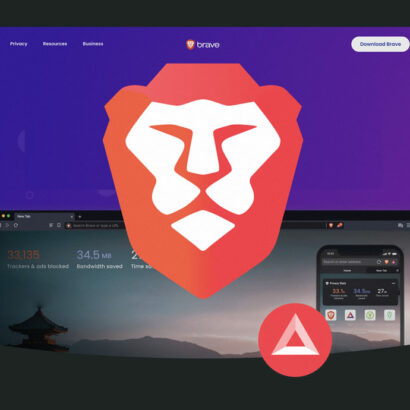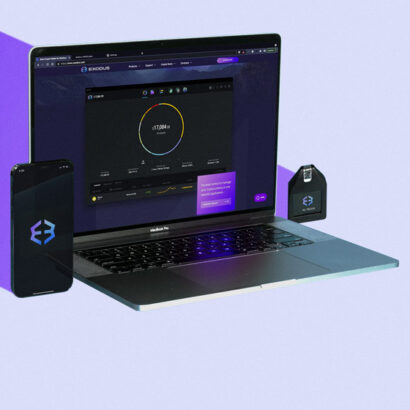Monero (XMR) is the most widely used privacy coin and was the first cryptocurrency to use encryption for significant improvements in privacy and fungibility over today’s most popular cryptos (like BTC).
On Monero, every user is anonymous by default. It’s difficult to impossible for anyone to track the sender, receiver, or even the amount of XMR that was sent or received.
The vast majority of cryptocurrencies, including Bitcoin and Ethereum, are “public” in nature. Peers can independently validate every single transaction on these blockchains, and blockchain transactions and addresses can also be traced back to real-world users and entities. Every transaction on these blockchain networks gets automatically stamped with the date, amount, and addresses involved. For all to see.
It’s not easy for the average person to go through this type of information, but it can be done.
While such an open and transparent architecture still brings the benefits of decentralization and blockchain technology, it also ends up at odds with the anonymity and privacy.
As a result, people looking for financial anonymity will find privacy coins like Monero appealing.
Key Takeaways:
- Monero was introduced as an open-source, privacy-focused cryptocurrency in 2014. It traces its origins back to the forking of the 2012-launched Bytecoin – the first digital currency to be written using privacy-friendly technology CryptoNote.
- To protect its users’ anonymity, Monero makes use of a variety of privacy-enhancing features. Because of the opaqueness of its blockchain, participants’ addresses are hidden, making transaction amounts and specifics anonymous.
- Specialized hardware is not required to mine XMR.
- Unfortunately Monero is also used for illegal operations including avoiding international sanctions and as a method of payment on the Dark Web. However, there are still excellent legal arguments for establishing a private cryptocurrency.
- With stealth addresses (enable users to generate one-time addresses) and ring secret transactions (hide transaction amounts), Monero has been quick to enhance cryptography for blockchain transactions.
- Monero continues to draw attention from cryptographers and researchers wanting to push the boundaries of what is possible in cryptocurrency since it has already pioneered quite a few advancements.
A Brief History of Monero
Monero stands for “from money” in Esperanto. It was created specifically to be unlinkable and untraceable. No two Monero transactions can be linked, as neither the origin or final destination of a transaction can be ascertained. Monero is a blockchain network (ledger) used for storing and facilitating peer-to-peer transactions using XMR. has intelligent cryptography in place to mask the sources, amounts, and destinations of all transactions by default.
The concept for Monero first appeared in a 2013 whitepaper for the open-source CryptoNote cryptocurrency protocol, which sought to address some of Bitcoin’s drawbacks. The first cryptocurrency to use CryptoNote was Bytecoin, which was introduced in the summer of 2012. While Bytecoin made a commendable effort in terms of anonymity, there were problems with its first distribution. It turns out that at launch, 80% of the coins that would ever be mined already existed.
This prompted a group of developers to fork Bytecoin in 2014 to form Bitmonero, a new venture. Later, the name was altered by dropping the “Bit” to become what is now known as Monero.
Five of the seven programmers who initially built Monero made the decision to remain anonymous. Only two of these developers are known: David Latapie and Riccardo Spagni, who was previously the project’s lead developer.
Spagni is also known as “Fluffypony” in crypto circles.
Benefits of Monero
Monero is an open-source project that is mostly supported by community contributions. Through the Monero Community Crowdfunding System (CCS), the project has received funding and support from hundreds of people worldwide.
Permissionless and Decentralized
The fact that Monero is open-source and completely permission-less makes it comparable to many other cryptocurrencies. A central authority cannot easily stop people from using crypto. Because of this, people without access to modern banking infrastructure can participate in the digital economy in ways they have never been able to. All they require is a device to connect to the internet and an internet connection.
Privacy and Anonymity
Users of Monero also benefit from privacy and anonymity. XMR gives people the freedom to conduct cryptocurrency transactions anytime they want for any purpose without being concerned about being watched by the government, hackers, or other outside parties.
However, since XMR coins cannot be traced, they also cannot be blacklisted by businesses for alleged illicit connections. This has raised concerns among some groups about the potential illicit use of Monero in the dark web or practices like illegal cross-border transactions by radical groups.
At the end of the day, it is important to remember that privacy and anonymity should not be associated with criminal activities alone. Much like one’s personal information (address, social security number, etc.) privacy of cash and finance is also a prerogative for many.
Fungibility
Absolute fungibility is another benefit of Monero over Bitcoin and other common cryptocurrencies.
The property of fungibility signifies that there is no difference between two units of a currency when they are replaced for one another.
BTC is fungible in that it is divisible, interchangeable and equal in value with any other BTC. However, since each BTC has a related transaction history that could potentially be connected to specific occurrences like fraud, gambling, or theft, it is possible to block, suspend, or close accounts that contain such units.
In this case, the tainted BTC could become non-fungible, resulting in losses for the account holders by locking or banning specific wallet addresses.
Due to Monero’s untraceable transaction history, users can participate in an open peer-to-peer network without worrying that other users can reject or ban their owned units.
Continuous Updates
Despite the fact that Monero has anonymous developers and an open-source code base, there are several significant distinctions between it and Bitcoin, one of which is how upgrades are handled. Monero’s software is set up to update automatically every six months, unlike Bitcoin, which is hesitant to fork and requires extensive discussion before implementing even the smallest modifications.
Low Transaction Size and Fees
Monero became the first billion-dollar cryptocurrency to use the much-anticipated “Bulletproofs” technology in 2018, which helps increase the scalability of blockchain privacy features.
The technology, developed by cryptographers Jonathan Bootle and Benedict Bunz, significantly reduces the weight of private transactions.
Bulletproofs tech has helped increase the efficiency of XMR transactions and result in at least an 80% reduction in the size of the average transaction and dramatically lower fees for the end-user.
Improved Scalability
The scalability of cryptocurrencies like Bitcoin is largely constrained. For instance, the block size limit for Bitcoin has long been 1 MB. This means that each of the blocks that are mined on the Bitcoin network every 10 minutes can hold no more than 1MB of transaction data.
Every once in a while, when multiple users attempt to complete Bitcoin transactions at once, the traffic network ends up congested. In these situations, users are compelled to pay higher validation fees in order to have their transactions included.
Monero solves this problem with its unique mechanism. There is no “pre-set” block size limit on Monero, meaning each block can contain more information about a single transaction. At the same time, its block reward-penalty scheme discourages the use of excessive block sizes, and thus deter spam transactions.
Building a Wider, Inclusive Community
Monero is not just transforming the privacy and security associated with cryptocurrencies —it’s also a pioneer of cutting-edge new technologies when it comes to blockchain and cryptography.
The Monero Project boasts of a capable research and development team with over 500 developers from around the world who have contributed to the project since its inception.
Anyone can join the numerous forums and chat rooms, and the community always welcomes new members, spurring further innovation on ground.
Privacy 101
Individual rights to privacy matters—even if you have nothing to hide.
— Anonymous
From the digital and technology ages, we have swiftly entered the surveillance age. Service providers today are able to gather, aggregate, and analyze key data on individual behavior in a volume and scope that was impossible only a few years ago, thanks to the rise of online service delivery, eCommerce, and digital transactions.
For instance, governments can now more closely monitor and censor anti-government websites. Facebook, Google, Amazon, and Apple are recording their users’ personal information, such as IP addresses, location information, and communication logs to suit their advertisers. An invisible marketplace is in the making, selling online behaviors, content consumption, and even financial transactions of users for profit-makers to leverage.
Such actions compromise not just the user’s ability to express themselves freely and safely on the internet, but also curtails their right to private communications, use of finances, and can limit their ability to make informed decisions. This makes privacy an important right for all – not just for people with something to hide, much in the same way that free speech is not only for those with something to say.
Most cryptos are pseudonymous and public by default. Privacy is not a built-in offering, and therefore, financial transactions are not entirely anonymous. Most blockchain transactions are visible to everyone and recorded on a public ledger. They can even be traced back to the original buyer and seller, leave alone other transaction details.
Privacy coins like Monero, on the other hand, are designed to tackle this very challenge. These cryptocurrencies make it difficult to link transactions together through enhanced encryption. Privacy coins are GDPR (General Data Protection Regulation)-compliant, and adhere to the GDPR’s direction that all blockchains should be “privacy preserving by design”. Privacy coins include very little information on the blockchain, making it very difficult and currently impractical to monitor them.
The other major privacy coin beside Monero is ZCash.
How Does Monero Work?
Privacy coins obscure a portion of user identification data to the point of complete anonymity. To conceal user information, privacy coins may employ one or more techniques, such as stealth or ring addresses. Monero employs both.
Stealth Addresses
The location of funds is hidden on the Monero network using stealth addresses. They accomplish this by having the sender create a one-time address from a public address that is only used for that particular transaction. Similar to Bitcoin, the recipient can still receive all of their payments at a single public address.
A private view key and a private spend key will be generated for each Monero user. While the private spend key functions similarly to a Bitcoin private key in that it is used to authorize payments, the private view key will allow them to examine all transactions connected to their account.
The use of a stealth address is required by Monero’s privacy by default policy, therefore you cannot choose not to use one. The public ledger is therefore automatically hidden, but you can still choose which parties can see your transactions.
Ring Signatures
A ring signature refers to a digital signature made by a member of a group holding some private keys. While it is possible for anyone to confirm that one of the participants has actually delivered the signature if they have access to the signature and the keys of the group members, they will not be able to identify the specific member who did it.
On these lines, the Monero wallet creates a ring out of other users’ keys it downloads from the blockchain for each XMR transaction. The transaction is anonymous since it is impossible for anyone watching to determine whose key was used to sign. These keys function as decoys, giving the impression that any member of the ring could have signed your transaction.
Taking this a notch higher, Monero introduced Ring Confidential Transactions (RingCT) in January 2017, which also conceal the value of transactions.
The Future
Monero (XMR) has long been the preferred cryptocurrency for individuals looking for reliable privacy guarantees. It features a passionate development community that is dedicated to enhancing the privacy of its users’ transactions.
The goal of enabling unlinkability and untraceability in cryptocurrencies is being furthered by new enhancements, such the inclusion of Kovri – a project that aims to further improve the privacy of the network by masking the IP addresses of Monero blockchain users.
Monero brings several benefits to the crypto ecosystem :
- Privacy – Monero makes it impossible to connect a transaction to an individual or track transactions to their source or destination.
- Affordable – Even when used utilized frequently, XMR fees shouldn’t become excessive because of its dynamic scalability.
- Autonomous – Users have complete liberty of deciding who can view their transactions.
There is an undoubted need for cryptocurrencies like Monero that bring about real anonymity and decentralization in a world that is shrouded by invasive technology and data stealth.
Monero has the ability to enable global transactions extremely immediately without requiring authorization from any authorities, thus bringing financial inclusivity and decentralization from repressive authorities.
Of course at the same time, the promise of privacy could be misused by participants of dark web markets, which provide a genuinely astounding selection of narcotics, firearms, and other illegal goods. Monero has the potential to become a preferred means for such illicit transactions, and there are plenty of examples to support this idea.
For example:
Reports suggest that nations like North Korea’s have employed Monero to circumvent international restrictions.
Unsurprisingly, government authorities tend to find the idea of a completely anonymous peer-to-peer global payment system to be disruptive and potentially harmful. In theory, it can be leveraged by anti-social elements. Based on this narrative, many authorities will try to do things to increase their power and influence over people.
Obviously Monero stands in direct opposition to this.
Conclusion
The first steps toward a more private digital currency may have been made by Bitcoin more than ten years ago, but Monero has come a long way toward achieving full financial anonymity. With its cutting-edge cryptography, stealth addresses, ring signatures, and resilience to ASICs, Monero has established itself as the largest privacy coin by market cap.
Additionally, XMR may be intriguing to any user who wants to test the limits of cryptography in cryptocurrencies, opening the door for monetary systems that permit people all over the world to save and pay without restriction.
Monero is governed by a responsible, innovative community who see privacy as a basic right.
XMR has established itself among the larger crypto markets. Many investors are viewing it as a useful addition to their portfolio, because they believe that cryptocurrency users will eventually demand more privacy, and Monero fits the bill perfectly. Of course, many investors also have good reason to be skeptical that it will succeed.
There is a real threat of governments trying to ban it or exchanges being pressured to delist XMR.
There is always going to be a strong case for the need for and right to privacy and autonomy.
At the time of this writing XMR/BTC was trending upwards.
#Monero has been holding up ok throughout the crypto contagion. Today, #XMR/BTC saw price levels not seen since May 2021.
Meanwhile, the $XMR/USD pair is slightly up +2% for the week while most major coins are -10% pic.twitter.com/ErS6rWIkid
— John Foss (@johnfoss69) November 21, 2022
Dear @SBF_FTX:
Thank you for not listing #XMR.
– The #Monero community
— Monero (XMR) (@monero) November 18, 2022

Where to Buy XMR
1.
Create an account
Provide your email address, country of residence and secure your account with a strong password
2.
Connect your funding method
Connect your card or bank account after Kraken verifies your account
3.
Buy Monero
Buy XMR (with as little as $10)





